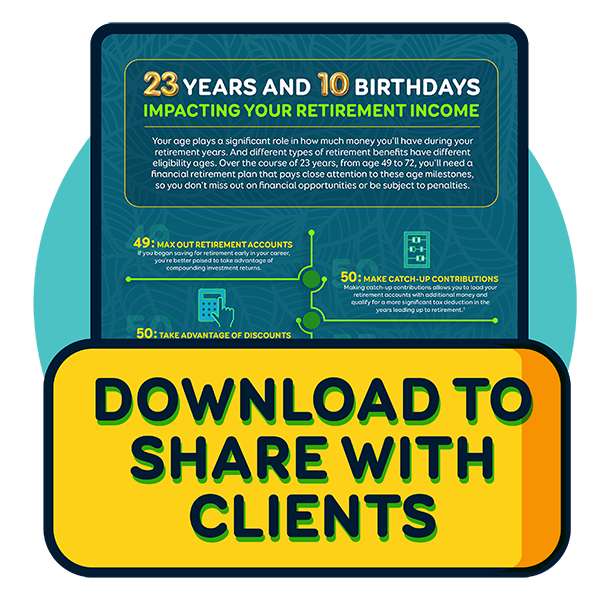Updated September 22, 2023, at 3:36 PM
Age and money are taboo topics when it comes to retirement planning.
Talking about money is quite often an emotional trigger. As a financial professional, you have to find that point in the retirement planning conversation that pokes at these concerns. But you need to do it in a way that doesn’t cause your client to shut down.
And don’t ask someone’s age since we all know the aging process can’t be slowed or stopped. As a financial professional, you can help clients recognize that time is crucial to drilling down their financial planning details. You want them to feel secure with the inevitable.
So, you need a conversation starter.
Chances are, you already have a successful retirement planning strategy in use at your firm. But as we discovered, it’s not the strategy that can make the conversation squeamish; it’s the topics. For generations, we’ve been taught age and money are taboo topics.
Below is your conversation starter. A failsafe to facilitate smooth, productive conversations.
“Your clients may have several different financial goals they wish to achieve but to reach them at the right point in life, they will benefit from having a financial strategy for every age.”
Franklin templeton
10 Birthdays Impacting Financial Retirement Planning
Over the course of 23 years, from age 49 to 72, it’s prudent to pay close attention to specific birthday milestones and how they relate to a retirement nest egg. There are rules to follow before someone stops working as well as a few to watch out for once retirement hits.
Your client’s age plays a significant role in how much they can expect to receive during their distribution phase of life. It’s also an indicator of what they need to do to avoid retirement account penalties.
Start the conversation before age 49 and keep the conversation going around those taboo topics!
Age 49: Max Out Retirement Accounts
Workers who begin to save for retirement early in their careers are best suited for taking advantage of compounding investment returns. Now’s the time to explain that by putting money in a qualified retirement contribution plan like a 401(k). The saver’s credit provides a tax break, and they might also benefit from an employer match.
Additionally, selecting an IRA as a savings option also includes tax incentives, depending on the type chosen.
Age 50: Take Advantage of Catch-Up Contributions
Making catch-up contributions is designed for anyone 50 and older. After maxing out contributions, talk with clients about the option to tuck more money than the usual contribution limits into their retirement accounts (401(k) and IRAs).
Remind them that one perk is that this may qualify them for a more significant tax deduction in the years leading up to retirement.
Related: 10 Pieces of Retirement Planning Advice Retirees Wish They Had Known Sooner
Age 50: Take Advantage of Senior Discounts
AARP is a non-profit, non-partisan organization that discounts everything from travel services to restaurants to identity theft protection for its members. It’s worth mentioning to clients watching their pennies that they might consider joining programs like this to save.
Age 55: Client’s 401(k) and the Rule of 55
The Rule of 55 is an IRS provision that allows withdrawals from a 401(k) before age 59½ while avoiding the 10% early withdrawal penalty. Take time to explain that, regardless of why they leave their employer, they must do it in the calendar year they turn 55 or later to be eligible for a penalty-free distribution.
Also, inform clients that it can’t be a withdrawal from a previous employer. The caveat? While they may have access to their money, it’s still considered income and is subject to federal taxes.
Age 59 1/2: The IRA Retirement Age
Holding onto an IRA for at least five years before reaching this age milestone means your clients can now take distributions and avoid the 10% early withdrawal penalty.
Discuss the tax implications of this distribution. Meaning, regarding their income and associated taxes, any nondeductible contributions (think Roth IRA funded with after-tax dollars) may be tax-free, but the money put into a traditional IRA and the associated growth earnings is taxable.
Some people who retire in their 60s live well into their 90s. With that 30-year gap, it’s important to plan their finances appropriately, so they don’t run short.
Age 62: Eligible to Begin Social Security Payments
Currently, eligible recipients can start collecting Social Security payments at age 62. However, monthly payments could be reduced by as much as 30% if payments begin before full retirement age.
On the flip side, choosing to work and collect simultaneously, could result in reduced payments by $1 for every $2 earned above $19,560. Now’s the time to talk to your clients about how their age and money intertwine.
Age 65: Medicare Eligibility Begins
This age can be tricky regarding the associated date, so start the conversation early to avoid penalties. There are seven months to Medicare open enrollment, and that window opens three months before the month someone turns 65.
The open enrollment period is important because Medicare Part B premiums increase by 10% for each 12-month period they’re eligible for benefits but didn’t enroll. If your client is waiting because of a work health plan, remind them that they have eight months to enroll without penalty once they do stop working.
Ages 66-67: Social Security Full Retirement Age
Anyone born between 1943 and 1954 qualifies at age 66. While those born after 1959 have to wait a year—until age 67.

It’s important to talk through this age as it’ll significantly impact your client’s nest egg. Explain that once they hit full retirement age, they can work while receiving Social Security benefits without having any of their payments withheld.
If they happen to be a baby boomer and choose to wait until age 68, they’ll receive 16% more. Younger generations who start at age 68 will see an increase of about 8% just for waiting a year.
Age 70: Boost Monthly Social Security Payments
Social Security payments increase by 8% each year between full retirement age and age 70. Pull out your client’s financial retirement plan and see if waiting makes sense.
Explain that baby boomers can increase their Social Security benefit by 32% by waiting until age 70 to sign up, boosting that $1,000 Social Security payment to $1,320 per month. People born after 1959 will get 24% more by claiming payments beginning at age 70. After age 70, there’s no additional benefit to waiting.
Related: Guide to Maximizing Your Social Security Benefits
Age 72: The 401(k) & IRA Required Minimum Distribution
Having money in a retirement plan such as a 401(k) or traditional IRA means the first distribution must be taken by April 1 of the year after turning 72 (70½ if they reached 70½ before January 1, 2020).
It might be worth mentioning that more than the minimum can be taken, but the entire withdrawal is taxable income. And point out that the penalty for missing a required minimum distribution (RMD) is a stiff 50% of the amount that should be taken.
Remember to talk about the option to delay RMDs: If someone continues to work after age 72 for a company they don’t own, they can delay 401(k) withdrawals from the retirement account at that job until they actually retire.
A qualified charitable distribution from an IRA directly to a qualifying charity can also satisfy the minimum distribution requirement. Roth IRAs don’t have withdrawal requirements in retirement.
Download: Get Our Corresponding Client-Facing Retirement Milestones Guide
Final Thoughts
As your clients age, there’s much more to their birthday than just cake and gifts. They need to know that talking about age and money is smart not taboo.
Beyond the age and money conversation, remember to ask clients what their retirement vision looks like. It may change over this 23-year span. Do they want to downsize and when? Do they plan to travel, do they have an emergency health plan and estate plan in place?
If you feel you’re missing a few answers, ask your client to come in and talk taboo topics. It’s never too early to ensure their financial retirement planning is on the right track.
For Financial Professional Use Only
The content within this article is for educational purposes only and does not represent legal, tax or investment advice. Customers should consult a legal or tax professional regarding their own situation. This presentation is not an offer to purchase, sell, replace, or exchange any financial product. Insurance products and any related guarantees, features and/or benefits are backed by the claims paying ability of an insurance company. Insurance policy applications are vetted through an underwriting process set forth by the issuing insurance company. Some applications may not be accepted based upon adverse underwriting results.



